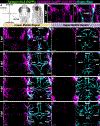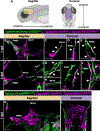Identification of distinct vascular mural cell populations during zebrafish embryonic development
- PMID: 38112237
- PMCID: PMC11065631
- DOI: 10.1002/dvdy.681
Identification of distinct vascular mural cell populations during zebrafish embryonic development
Abstract
Background: Mural cells are an essential perivascular cell population that associate with blood vessels and contribute to vascular stabilization and tone. In the embryonic zebrafish vasculature, pdgfrb and tagln are commonly used as markers for identifying pericytes and vascular smooth muscle cells. However, the overlapping and distinct expression patterns of these markers in tandem have not been fully described.
Results: Here, we used the Tg(pdgfrb:Gal4FF; UAS:RFP) and Tg(tagln:NLS-EGFP) transgenic lines to identify single- and double-positive perivascular cell populations on the cranial, axial, and intersegmental vessels between 1 and 5 days postfertilization. From this comparative analysis, we discovered two novel regions of tagln-positive cell populations that have the potential to function as mural cell precursors. Specifically, we found that the hypochord-a reportedly transient structure-contributes to tagln-positive cells along the dorsal aorta. We also identified a unique mural cell progenitor population that resides along the midline between the neural tube and notochord and contributes to intersegmental vessel mural cell coverage.
Conclusion: Together, our findings highlight the variability and versatility of tracking both pdgfrb and tagln expression in mural cells of the developing zebrafish embryo and reveal unexpected embryonic cell populations that express pdgfrb and tagln.
Keywords: hypochord; mural cell progenitor; pericyte; perivascular cells; sclerotome; vSMC; zebrafish.
© 2023 American Association for Anatomy.
Conflict of interest statement
Competing Interests:
The authors declare that they have no conflicts of interest.
Figures















Update of
-
Identification of overlapping and distinct mural cell populations during early embryonic development.bioRxiv [Preprint]. 2023 Apr 5:2023.04.03.535476. doi: 10.1101/2023.04.03.535476. bioRxiv. 2023. Update in: Dev Dyn. 2024 May;253(5):519-541. doi: 10.1002/dvdy.681. PMID: 37066365 Free PMC article. Updated. Preprint.
Similar articles
-
Identification of overlapping and distinct mural cell populations during early embryonic development.bioRxiv [Preprint]. 2023 Apr 5:2023.04.03.535476. doi: 10.1101/2023.04.03.535476. bioRxiv. 2023. Update in: Dev Dyn. 2024 May;253(5):519-541. doi: 10.1002/dvdy.681. PMID: 37066365 Free PMC article. Updated. Preprint.
-
Conserved and context-dependent roles for pdgfrb signaling during zebrafish vascular mural cell development.Dev Biol. 2021 Nov;479:11-22. doi: 10.1016/j.ydbio.2021.06.010. Epub 2021 Jul 24. Dev Biol. 2021. PMID: 34310924 Free PMC article.
-
Regenerating vascular mural cells in zebrafish fin blood vessels are not derived from pre-existing mural cells and differentially require Pdgfrb signalling for their development.Development. 2022 Apr 1;149(7):dev199640. doi: 10.1242/dev.199640. Epub 2022 Apr 5. Development. 2022. PMID: 35297968 Free PMC article.
-
Pericyte Biology in Zebrafish.Adv Exp Med Biol. 2018;1109:33-51. doi: 10.1007/978-3-030-02601-1_4. Adv Exp Med Biol. 2018. PMID: 30523588 Review.
-
Zebrafish genetics and formation of embryonic vasculature.Curr Top Dev Biol. 2005;71:53-81. doi: 10.1016/S0070-2153(05)71002-4. Curr Top Dev Biol. 2005. PMID: 16344102 Review.
Cited by
-
Endothelial cell Piezo1 promotes vascular smooth muscle cell differentiation on large arteries.Eur J Cell Biol. 2025 Mar;104(1):151473. doi: 10.1016/j.ejcb.2024.151473. Epub 2024 Dec 20. Eur J Cell Biol. 2025. PMID: 39729736
-
Endothelial cell Piezo1 promotes vascular smooth muscle cell differentiation on large arteries.bioRxiv [Preprint]. 2024 Jun 12:2024.06.11.598539. doi: 10.1101/2024.06.11.598539. bioRxiv. 2024. Update in: Eur J Cell Biol. 2025 Mar;104(1):151473. doi: 10.1016/j.ejcb.2024.151473. PMID: 38915529 Free PMC article. Updated. Preprint.
-
Hemodynamics regulate spatiotemporal artery muscularization in the developing circle of Willis.bioRxiv [Preprint]. 2024 Apr 12:2023.12.01.569622. doi: 10.1101/2023.12.01.569622. bioRxiv. 2024. Update in: Elife. 2024 Jul 10;13:RP94094. doi: 10.7554/eLife.94094. PMID: 38077062 Free PMC article. Updated. Preprint.
-
Hemodynamics regulate spatiotemporal artery muscularization in the developing circle of Willis.Elife. 2024 Jul 10;13:RP94094. doi: 10.7554/eLife.94094. Elife. 2024. PMID: 38985140 Free PMC article.
References
Publication types
MeSH terms
Substances
Grants and funding
LinkOut - more resources
Full Text Sources
Research Materials
Miscellaneous

